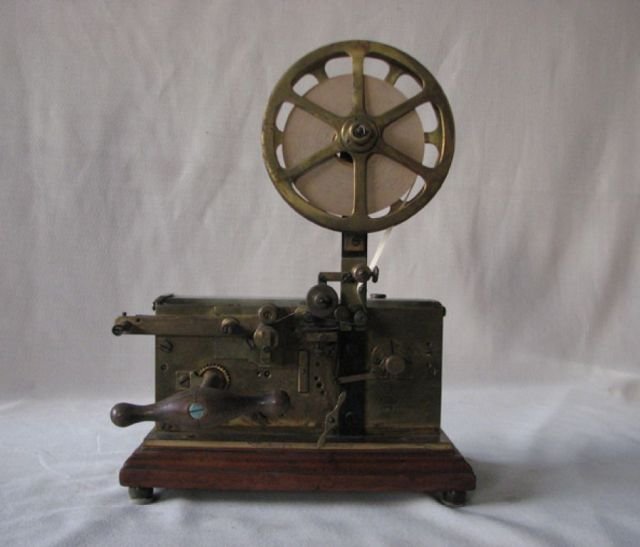MORSE TELEGRAPH WITH KEYPAD

-
Item owner - FNM
-
Category - FNM Collection
-
Inventory - 0207
-
Author - E. Longhi
-
Dimensions - 36x28x14 cm
-
Dating - 1900-1910
A brass box in the form of a parallelepiped anchored to a wooden base. A rod on its top surface supports a brass reel with a roll of paper on it, the end of which is threaded between a series of pairs of rollers that guide and pull it. On the outside, on the front, is a rotating rod with a grip and other gear mechanisms. It contains winding mechanisms, and is wound up using the rotating rod on the outside. An integral part of the machine is a key consisting of a little wooden base on which a brass bar hinged at the 3/4 point of its length onto a support is mounted; at the end of its long side is a manipulator key or button, while at the other end is a needle facing downward which touches the needle below it, anchored to the wooden base. Brass terminals on the base ensure electrical connection with the telegraph circuit.
It transmits communications over long distances using conventional Morse alphabet in dot-dash binary code. It was used by railway stations to send messages about train circulation. At one time, in stations offering this service, it was used to send telegrams over the Italian post office’s national network. This telegraph was used from the early twentieth century until the 1960s.
Pressing and releasing the manipulator key sends impulses which open or close a circuit powered with DC current connected to a receiver, which uses an electromagnet to work a lever with a writing tip. This writes a dot or a dash on a roll of paper, which is moved by a manually charged spring. The combination of dots and lines makes up the message to be conveyed, written in Morse code.
In the 1840s success finally came to Samuel Morse, who invented an electric telegraph system employing a single wire and came up with a special code, known as Morse code, encoding the letters of the alphabet as a sequence of impulses differing in duration (dots and dashes).
He managed to patent his invention and obtain government support in the United States, and on 24 May 1844 the first official message was sent between the cities of Washington and Baltimore.
The system soon became popular in all the world’s continents, forming a dense grid, with fine tuning to introduce glass or ceramic insulators, copper wire in place of iron, and a duplex system which increased the length of the dashes and improved the machine's efficiency. A specialised category of telegraph operators formed as a result, some of whom were able to type in Morse code at speeds of up to 80 - 100 characters a minute.
The nodes of the network, intermediate telegraph offices (relays), routed messages the right way to their destination. Note that the work was performed by hand: the messages received were read and delivered to the worker who sent them again over the next segment, according to their destination. The system was partially automated with the introduction of perforated ribbon and automatic transmitters.
In addition to private messages, the telegraph network carried news from correspondents to newspaper editors: this was the age of the birth of the press agencies, beginning with Reuters.
The telegraph system came to Italy in 1852, in the Kingdom of the Two Sicilies.